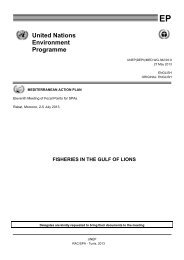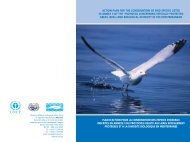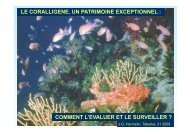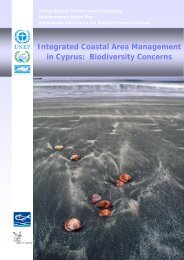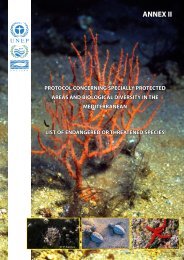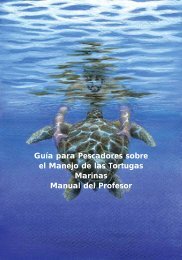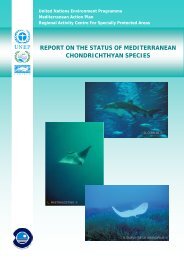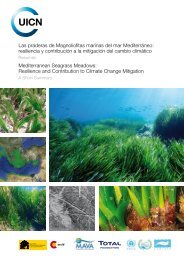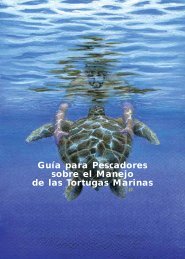Proceedings of the Second Mediterranean Symposium on Marine
Proceedings of the Second Mediterranean Symposium on Marine
Proceedings of the Second Mediterranean Symposium on Marine
Create successful ePaper yourself
Turn your PDF publications into a flip-book with our unique Google optimized e-Paper software.
PROCEEDINGS OF THE SECOND MEDITERRANEAN SYMPOSIUM ON MARINE VEGETATION (ATHENS, 12-13 DECEMBER 2003)<br />
34<br />
ANTHROPOGENIC IMPACTS ON MARINE<br />
VEGETATION IN THE MEDITERRANEAN<br />
Charles F. BOUDOURESQUE, Sandrine RUITTON and Marc VERLAQUE<br />
Centre d'Océanologie de Marseille, UMR 6540, Campus <str<strong>on</strong>g>of</str<strong>on</strong>g> Luminy, 13288 Marseilles cedex 9, France<br />
ABSTRACT<br />
The noti<strong>on</strong> <str<strong>on</strong>g>of</str<strong>on</strong>g> plant kingdom, comm<strong>on</strong>ly accepted since <str<strong>on</strong>g>the</str<strong>on</strong>g> time <str<strong>on</strong>g>of</str<strong>on</strong>g> Linnaeus (18 th<br />
century) actually encom-passes a highly polyphyletic set <str<strong>on</strong>g>of</str<strong>on</strong>g> taxa bel<strong>on</strong>ging to Procaryota<br />
and Eucaryota and, within <str<strong>on</strong>g>the</str<strong>on</strong>g> Eucaryota, to six out <str<strong>on</strong>g>of</str<strong>on</strong>g> <str<strong>on</strong>g>the</str<strong>on</strong>g> eight kingdoms, namely<br />
Opisthok<strong>on</strong>ts, Amaebobi<strong>on</strong>ta, Plantae, Stramenopiles, Alveolobi<strong>on</strong>ta and<br />
Discicristobi<strong>on</strong>ta. Therefore, for at least two decades, plants (and vegetati<strong>on</strong>) have no<br />
l<strong>on</strong>ger been scientific c<strong>on</strong>cepts but a matter <str<strong>on</strong>g>of</str<strong>on</strong>g> customary usage. Biodiversity means <str<strong>on</strong>g>the</str<strong>on</strong>g><br />
variety am<strong>on</strong>g living organisms including, inter alia, diversity within species, between<br />
species, ecosystems and landscapes and functi<strong>on</strong>al diversity. As far as species diversity<br />
is c<strong>on</strong>cerned, point diversity, alpha diversity, beta diversity, gamma diversity and epsil<strong>on</strong><br />
diversity should be c<strong>on</strong>sidered separately, since anthropogenic impact can increase alpha<br />
diversity while reducing gamma diversity. The <str<strong>on</strong>g>Mediterranean</str<strong>on</strong>g> Sea may be c<strong>on</strong>sidered as<br />
a hot spot <str<strong>on</strong>g>of</str<strong>on</strong>g> marine epsil<strong>on</strong> species diversity. The ranking <str<strong>on</strong>g>of</str<strong>on</strong>g> <str<strong>on</strong>g>the</str<strong>on</strong>g> relative importance <str<strong>on</strong>g>of</str<strong>on</strong>g><br />
human impact <strong>on</strong> biodiversity must take into account <str<strong>on</strong>g>the</str<strong>on</strong>g> time necessary for <str<strong>on</strong>g>the</str<strong>on</strong>g> impact<br />
to become reversible: from a few days to millennia. Thus, coastal development, species<br />
introducti<strong>on</strong>, species extincti<strong>on</strong> and global warming are <str<strong>on</strong>g>of</str<strong>on</strong>g> major c<strong>on</strong>cern. (i) Coastal<br />
development especially c<strong>on</strong>cerns shallow and highly prod-uctive bottoms with seagrass<br />
and o<str<strong>on</strong>g>the</str<strong>on</strong>g>r macrophyte communities. In <str<strong>on</strong>g>the</str<strong>on</strong>g> <str<strong>on</strong>g>Mediterranean</str<strong>on</strong>g>, both tourism (a third <str<strong>on</strong>g>of</str<strong>on</strong>g> total<br />
world tourism) and <str<strong>on</strong>g>the</str<strong>on</strong>g> populati<strong>on</strong> explosi<strong>on</strong> are boosting coastal development. (ii) The<br />
<str<strong>on</strong>g>Mediterranean</str<strong>on</strong>g> Sea c<strong>on</strong>stitutes a hot spot for species introducti<strong>on</strong>: introduced species<br />
nowadays represent 6,5% <str<strong>on</strong>g>of</str<strong>on</strong>g> its flora, and <str<strong>on</strong>g>the</str<strong>on</strong>g>ir number is doubling every twenty years.<br />
(iii) No "plant" species are known to have become extinct due to human impact, but<br />
many species and communities are vulne-rable, i.e. have experienced a dramatic decline<br />
over <str<strong>on</strong>g>the</str<strong>on</strong>g> last decades (e.g. Lithophyllum byssoides rims, Posid<strong>on</strong>ia oceanica meadows<br />
and Cystoseira forest) (iv) Finally, global warming (partly due to natural climatic shift) can<br />
upset <str<strong>on</strong>g>the</str<strong>on</strong>g> existing equilibrium.<br />
INTRODUCTION<br />
Human impact <strong>on</strong> biological diversity in <str<strong>on</strong>g>the</str<strong>on</strong>g> <str<strong>on</strong>g>Mediterranean</str<strong>on</strong>g>, in particular <strong>on</strong> <str<strong>on</strong>g>the</str<strong>on</strong>g> benthic<br />
vege-tati<strong>on</strong>, is generally thought to be high, due to tourism (<str<strong>on</strong>g>the</str<strong>on</strong>g> <str<strong>on</strong>g>Mediterranean</str<strong>on</strong>g> regi<strong>on</strong><br />
accounts for a third <str<strong>on</strong>g>of</str<strong>on</strong>g> <str<strong>on</strong>g>the</str<strong>on</strong>g> total number <str<strong>on</strong>g>of</str<strong>on</strong>g> tourists worldwide), populati<strong>on</strong> explosi<strong>on</strong> and<br />
<str<strong>on</strong>g>the</str<strong>on</strong>g> subsequent coastal development.




